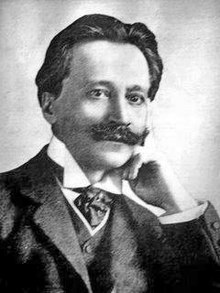Ricardo Castro
This articleneeds additional citations forverification.(August 2008) |
Ricardo Castro | |
|---|---|
 | |
| Born | 7 February 1864 Durango,Mexico |
| Died | 27 November 1907 (aged 43) Mexico City,Mexico |
Ricardo Castro Herrera(Rafael de la Santísima Trinidad Castro Herrera) (7 February 1864 – 27 November 1907) was a Mexican concertpianistandcomposer,considered the lastromanticof the time ofPorfirio Díaz.
Life
[edit]Castro was born at Hacienda de santa Bárbara,Durango.His father, Vicente Castro, was a deputy congressman; his mother was María de Jesús Herrera. Castro began his music education with Pedro H. Ceniseros. In 1879 his family moved toMexico Citywhere the boy entered theNational Conservatory of Musicand studied piano with Juan Salvatierra andJulio Ituarte,He studiedharmonyandcounterpointwithMelesio Morales.He finished all his studies in just 5 years, half of the usual 10. He graduated in 1883.
Castro began his musical career as a concert pianist and composer before finishing his studies. In 1882, he won two prizes. At 19, Castro finished his First Symphony in C Minor; the symphony was premiered in 1988, 81 years after his death.
In 1883 the Government of Mexico chose some of Castro's works to send to Venezuela for theSimon Bolivarcentenary and later in 1884 he made a concert tour throughUnited States.
1896 was the year of the first premiere of the first act of Castro's operaAtzimba.The second act is lost.
Castro received a scholarship from theGovernment of Mexicoand went toEuropefrom 1903 to 1906 to give master classes in conservatories inParis,Brussels,Rome,MilanandLeipzig.He published in Paris many Mexican dances for piano in the Habanera style. He studied withTeresa Carreñowhile in Europe. When he returned to Mexico he was appointed music director of theNational Conservatory of MusicbyJusto Sierraand kept that work until he died of pneumonia inMexico Cityin November 1907.
Castro's music for piano tends to be very colourful and sentimental with a kind of virtuosity in the style of Liszt. He often connects many musical themes in brilliant passages of virtuosity.[1]
References
[edit]- ^Moreno Rivas, Yolanda. 1995.Rostros del Nacionalismo en la Música mexicana:un ensayo de interpretación.Segunda Edición[México DF] Universidad Nacional Autónoma de México. Escuela Nacional de Música. p.84, 85.
External links
[edit]
- 1864 births
- 1907 deaths
- 19th-century classical composers
- 19th-century classical pianists
- 19th-century male musicians
- 20th-century classical composers
- 20th-century classical pianists
- 20th-century male musicians
- Deaths from pneumonia in Mexico
- Male classical pianists
- Mexican classical composers
- Mexican classical pianists
- Mexican male classical composers
- Mexican Romantic composers
- Musicians from Durango
- National Conservatory of Music of Mexico alumni
- North American composer stubs
- Mexican musician stubs
- Classical pianist stubs
